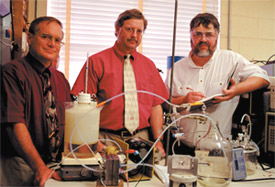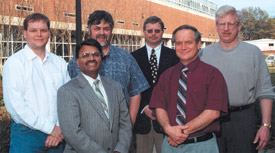by Neika D. Nix and Elizabeth M. Smith

Pumping gas into your car may be unnecessary in a few years. Instead, many vehicles on the highways could run on hydrogen fuel cells. Research at The University of Alabama is helping move this scenario toward reality.
A group of UA researchers recently received a grant from the U.S. Department of Energy Experimental Program to Stimulate Competitive Research worth $400,000 a year for the next six years that will allow them to help develop the future of automotive technology.
Several faculty members in chemistry, chemical engineering and metallurgical and materials engineering, along with mechanical engineers in UA’s Center for Advanced Vehicle Technologies, known as CAVT, are working to develop the complex technology needed to make fuel cell energy a realistic and reliable alternative to gasoline-fueled cars.
Their efforts focus on a plan by the DOE to advance research on hydrogen-based fuel cells as a way to power the cars of the future. With the aid of this grant, the University will have the potential to become a nationally recognized fuel cell research center.

The fuel cell has been called the “energy source for a green planet,” developed to power vehicles known in the automobile industry as “clean machines,” explained Dr. Alan Lane, a UA professor of chemical engineering. The technology harnesses the chemical energy of hydrogen and oxygen to generate electricity, with heat and water being the only by-products. Hydrogen can be obtained from other fuels, such as natural gas, methanol, or even gasoline, and has fewer emissions than current systems that use combustion processes.
The benefits of fuel cell automobiles can be cleaner air, economic growth and less dependence on foreign oil, Lane said. But he pointed out that present drawbacks, which include the high costs of producing fuel cells, low overall efficiency and the lack of an available hydrogen infrastructure, are still preventing the technology from becoming the next generation of power production.
“The main goal of the UA research team is to overcome these difficulties and help develop fuel cells that are economically feasible for commercial use,” Lane said. “We are working to design fuel cells at a decreased cost and increased efficiency level.”
A fuel cell research team was formed at UA in April 1999 with funding provided by the CAVT, leading to additional funding from the Environmental Protection Agency and other sources in 2001. With the new award, funding for fuel cell research at the University totals approximately $1 million per year.
“The driving force behind all of this research is a basic quest for new energy sources because our stores of energy are limited,” said Dr. Anthony Arduengo, Saxon Professor of Chemistry. “This research will not eliminate the need for other alternative energy research, but it will help. As a scientist, I like being involved in that.”
Another major goal of the research is to design a lightweight and easily manufactured fuel cell engine for cars. The increased interest in this technology has already sparked virtually every major automobile manufacturer in the world to begin developing and producing a prototype fuel cell vehicle.
“Because of the automobile manufacturers in this area, it makes good sense for the University to be involved in this project,” said Dr. Joseph Thrasher, UA professor and department chair of chemistry. “If fuel cells become the power plant for the future automobile, it is important that the University be involved in that research as well as in educating a workforce.”
Among the College of Engineering faculty involved in the research are Lane; Dr. John Wiest, associate professor of chemical engineering; Dr. Ramana Reddy, ACIPCO professor of metallurgical and materials engineering; and Dr. Giovanni Zangari, associate professor of metallurgical and materials engineering. In addition to Arduengo and Thrasher from the chemistry department of the College of Arts and Sciences, Dr. Shane Street, assistant professor of chemistry, is a member of the research team. Additional research activities involve mechanical engineering faculty, Drs. John Baker and Keith Woodbury, both associate professors; and Drs. Steve Shepard and Keith Williams, both assistant professors.
The scientists agree there’s much to be done before fuel cells become part of our everyday lives. “Research and education are what we’re all about,” Thrasher said. “The internal combustion engine has been around for more than 100 years, and there’s still work being done. We are just beginning to learn about what fuel cells can do. The future for this research is bright.”